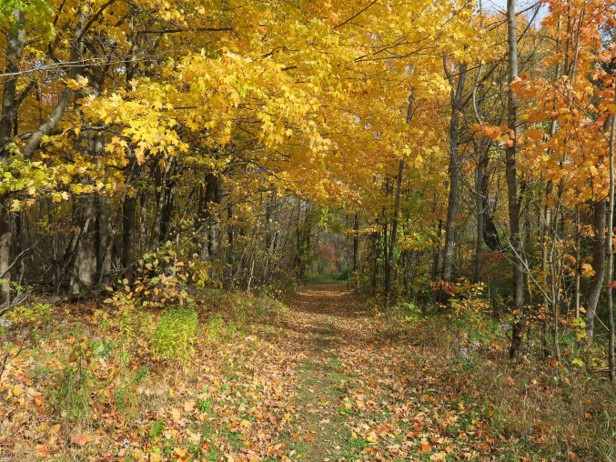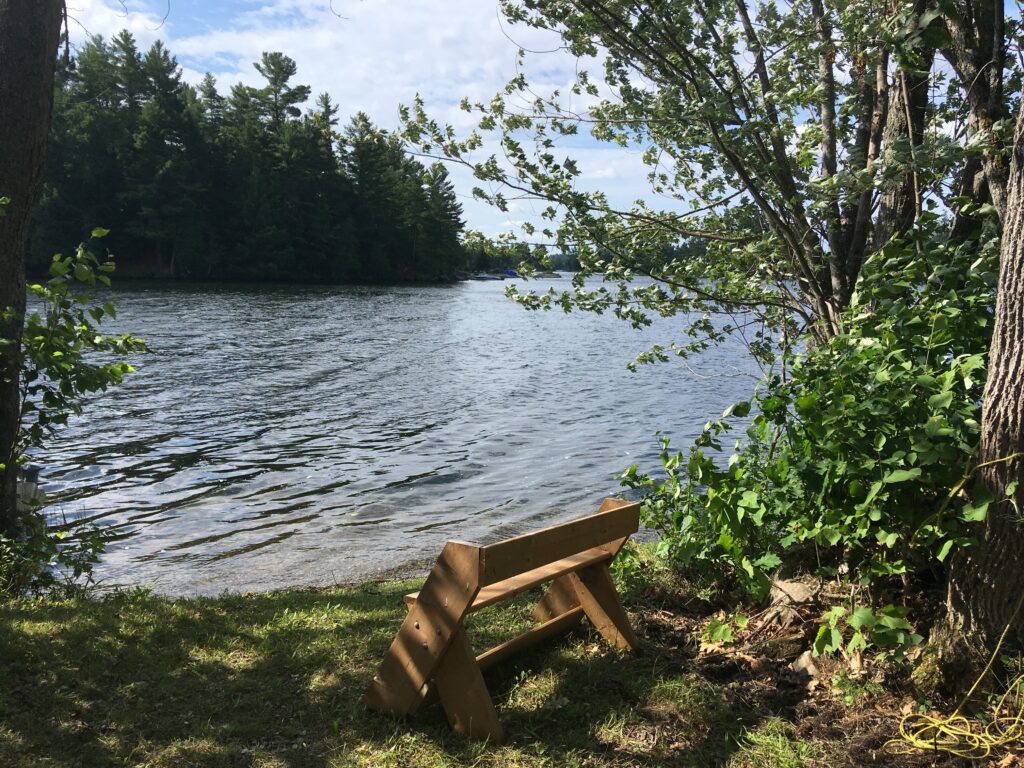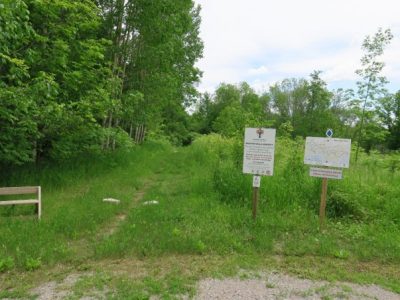
These trails would not have been possible without the support of donors, volunteers, and neighbouring landowners. Thanks to all who helped locate the property’s old unmanaged trails, cleared and groomed them and continue to maintain them today.
While enjoying the natural beauty of the area please be careful. Wear bug spray, avoid poison ivy, and stick to trails to avoid picking up seeds of invasive species and spreading them to other areas.

Yellow and Brown Trails
This property sits primarily on limestone bedrock.

Red Trail
This property includes a hilltop lookout and one of the largest undeveloped stretches of shoreline on Stony Lake.

Blue Trail
Several other landowners have also generously provided permission for the trail network to cross over their private lands.
The Ingleton-Wells property covers 73 acres and was donated by the Ingleton and Wells families in 2011. These trails were opened to the public in 2016.
The property was farmed for many years by the Reid and then McCauley families until 1987. It was also used for a riding stable operated by Sherman Preston until 1961.
The land was originally settled and cleared for agricultural use at some point in the 1800s. Evidence of the farm can still be seen here including the foundation of a house, flower beds of Day Lilies, Poppies, Lilacs and Honeysuckle. A small apple orchard sits on the eastern edge of the former farm.
The barn that was located in the field by the parking lot was removed in approximately 2010 by local builder Larry Burton. The wooden beams were used in the construction of distinctive homes along the nearby Boshing Channel.
What you see around you is a disturbed landscape that is undergoing a natural rewilding process.
EXPLORE THE TRAILS
The Ingleton-Wells property includes three large areas of meadows. These meadows are former agricultural fields and orchards.
These open meadows provide a diverse environment where you can see how nature is changing and rewilding the former farm.
The meadow features Milkweed, Brome Grass, Goldenrod, and Vetch. A small apple orchard that still bears abundant fruit is located in the northern meadow.
This landscape supports many plants and animals. Milkweed helps support the recovery of the threatened monarch butterflies. There are nesting boxes here for bluebirds. You will often hear the “teacher, teacher, teacher” call of the ovenbird, or the sudden drumming of a ruffed grouse.
The property sits on the transition area between southern and northern Ontario. It is where the Canadian Shield and the Great Lakes-St. Lawrence Lowlands meet. This is known as “The Land Between.”
This unique landscape features rock barrens, alvars, savannahs, fens, and meadow marshes. It is the northern limit for some species including white oaks, chorus frogs, and the common crow. It is the southern limit for others like grey wolves, moose, river otter, American ravens, and the breeding range of the common loon.
Unique species such as the five-lined skink, Ontario’s only lizard are found here along with many reptiles and amphibians.
The geology here was created by bedrock material, folding and glacial processes. This area of the Canadian Shield is of Precambrian Age which was 4.6 billion years ago in the earliest part of the earth’s history.
Around you are some of the oldest rocks in the world.
During the last glaciation period, ice as thick as 2,600 to 3,000 metres (8,000-10,000 feet) or more covered this area. When the ice retreated approximately 11,700 years ago it gouged out the five Great Lakes and the many other smaller lakes (including Stony Lake) found across the Canadian Shield.
The lower valleys in this area drain and collect water from rain and snowmelt. As a result, white cedars, a water-loving species, grow here.
The branches of the cedars restrict wind and heavy snow deposits, making this area a favourite for white-tailed deer. The deer are found here year-round and there are tracks and pellets in many places along the trail.
This is part of a known deer wintering area (look for their tracks in the snow!) that extends north and east into portions of the Peterborough Crown Game Preserve.
Porcupines and hares are common. Also, signs of eastern coyotes and black bears are sometimes spotted.
Birds found here include black-capped chickadees, woodpeckers, owls, warblers, hawks, and ruffed grouse.
The forest you see around you was not cleared for farming. It is now composed of older-aged species like sugar maple, beech, and oak.
When this property was farmed, maple sap was collected here to make syrup.
Bird species found in this area include pileated woodpeckers, barred owls and a nesting pair of red-shouldered hawks.
Spring wildflowers are common on the hillsides here. This includes trilliums, Dutchman’s breeches, hepaticas and wild leeks. These wildflowers help support populations of pollinator species like bees and butterflies.
Life beneath the forest floor is diverse and abundant.
Water pools in this area during the spring and attracts two types of aquatic salamanders: the spotted salamander and the blue spotted salamander. Both of these salamanders lay eggs and spend their early lives as larvae in water before emerging as adults to live on the forest floor.
Two other species, the eastern red-backed salamander and the four-toed salamander are also found in these forests. Unlike others, they do not have aquatic life stages. While they can be very common, salamanders are rarely seen after they finish breeding each spring.
The spotted salamander has a black and grey body with yellow spots. The blue-spotted salamander has small blue spots all over its body and the body colour ranges from black to blueish-black.
Red-backed salamanders have a thick red stripe that goes from the tip of its nose to the tip of its tail. The red-backed salamander is unique because it doesn’t have lungs and breathes through its skin by absorbing oxygen from water in moist forest areas.
These vernal pools often dry up completely over the summer months. It is critical that the larval aquatic salamanders have emerged as adults by that time.
This site provides one of the prettiest elevated views on the property and is a perfect spot to relax and reflect on the sense of place you are in.
Human disturbance has included clearing of forests, removal of stones, and extraction of gravel for local roads.
This land has been altered over time, but now that it has been protected it is returning to a more natural condition. The area that you see below provides sunny openings. They serve as basking areas for snakes and nesting sites for birds. It also supports diverse vegetation and wildlife. The wildflowers that grow here attract pollinator insects.
A bat summer roosting box has been placed in this location. Some species of bats, like the endangered little brown bat, are at risk due to fungus infections during their winter hibernation periods.
This outstanding and iconic site typifies the treasured and exclusive landscape of Stony Lake. The forest features large older growth White Pines and White Oak, species that are important in the area.
There are three large heritage white oak trees on this land. The largest, the massive “Viking Oak” is located south of the property on Viamede Resort’s section of the blue trail.
Large acorn crops in the fall attract red and grey squirrels, chipmunks, white-tailed deer, wild turkeys and black bears.
Some elements of our biodiversity are under threat. Species at risk are of particular concern on KLT properties. They represent further losses of natural biodiversity.
Butternut is an endangered tree that is disappearing due to a fungus called butternut canker. Of the 37 butternut trees originally found on the property there are only a few left.
All butternut trees on the property have been inventoried, labelled with metal tags and their health has been assessed.
Due to this fungus, the reproduction of butternut trees is fragile. This is why several sapling size trees have been fenced to prevent browsing by wildlife. Many seedlings have been planted but they are also succumbing to the disease. Efforts are currently being made to locate more canker-resistant individuals of the species.
If you have a question or would like to learn more about Kawartha Land Trust please email [email protected].